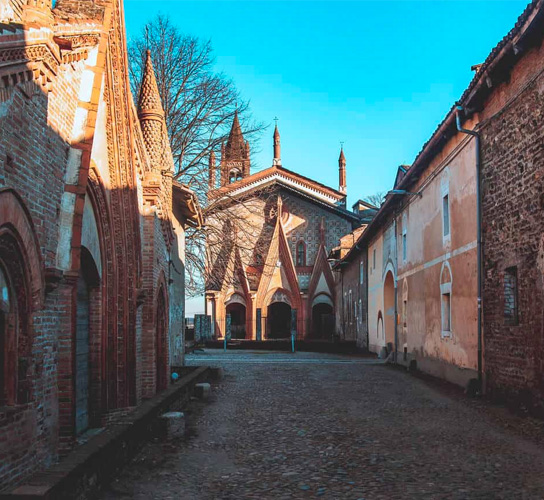History of the Precettoria (Preceptory)
The Precettoria of Sant’Antonio di Ranverso (Preceptory of St. Anthony of Ranverso) arises, with its unique shape, along the Via Francigena (French road), in the lower Susa Valley, between Buttigliera Alta and Rosta, around 20 km away from Turin. Inspired by trends from beyond the Alps, its gothic style represents a rarity in the artistic Italian landscape.
The first settlements in the complex date back to the XII century, then destined to become the Preceptory itself: a convent, a guesthouse, and a hospital to welcome the needy and people afflicted by the shingles or “Sacred Fire” (Ignis Sacer). The Via Francigena represented a crucial crossroads for pilgrims who set out in search of grace on the road to Jerusalem and toward the prominent sanctuaries of Christianity.
For centuries, the Ranverso Abbey, which developed around the ancient hospital, carried on a primary role of welcome and refreshment for sick people, even during the plague outbreak, from the 14th century onwards.
Today, we can see only a few traces of the romantic-styled original heart of the building, identified from the bell tower and the convent. The Preceptory was often renovated between the XII and XV centuries, leading it to take on the Gothic forms that we can still admire today.
The Architecture of Sant’Antonio di Ranverso
The Church is the beating heart of the entire Precettoria, with its splendid asymmetric façade enriched by a triumph of terracotta wimpergs and pinnacles. Those, together with the sleek apse, represent Ranverso’s Gothic spirit. The Sacristy and the Cloister complete the structure, even though the visitors’ most admired spot is the small porch just before the Church entrance.
Built around the mid-XIV century, it is characterized by cross vaults supported by pilasters. But the small sculptures that décor capitals and shelves, with human heads, devils, and animals, are the most surprising elements that arouse curiosity in the visitors. Sometimes, these figurines allegorically recall the eternal conflict between good and evil.
The surrounding buildings constitute the Concentrico, the center of the ancient Ranverso’s life. Here, the Hospital, or Spedale, was the most crucial place, whose façade, with its 15th-century terracotta decors, is still visible today.
Inside the abbey of Sant’Antonio di Ranverso, in the pillars and columns, we can appreciate the Gothic style declined in decorative form.
Among the great masterpieces of the Ranverso Abbey, we can admire the Polyptych of the Nativity, created in 1531 by Defendente Ferrari, and the frescoes that decorate the Sacristy and the Presbytery created by the Turin painter Giacomo Jaquerio, a leading exponent of international Gothic.
Jaquerio, supported by his artisans, painted plentiful works here, among them the “Salita al Calvario” (Ascent to Calvary) with realistic and tragic traits. The only handwritten signature of Jaquerio emerged during the restoration, aside from the “Madonna in trono” (The Madonna on the Throne) in 1914.
Virtual tour of the Precettoria
What’s up in Ranverso
Find out all the exhibitions, cultural events, and upcoming initiatives at the Precettoria of Sant’Antonio di Ranverso.
Your special events at the Precettoria of Ranverso
Sant’Antonio di Ranverso venues and locations are available for events and cultural activities.

Info and Contacts
Località Sant’Antonio di Ranverso
10090 Buttigliera Alta (TO)
+39 011 6200603
ranverso@biglietteria.ordinemauriziano.it